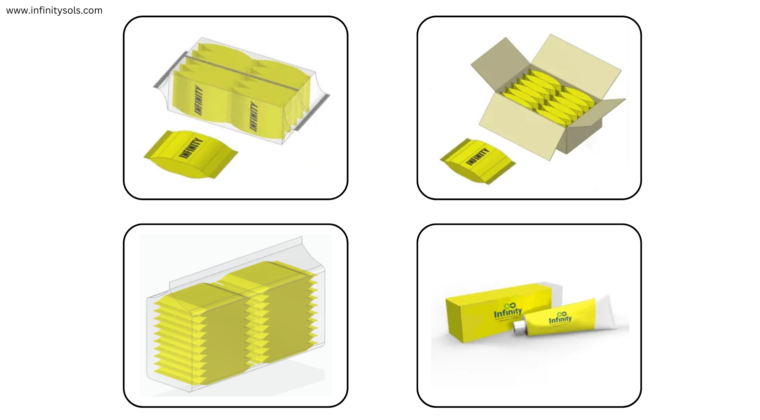Secondary packaging plays a crucial role in ensuring the safe and efficient distribution of products from manufacturers to end consumers. It combines protective functions with branding opportunities, information delivery, and logistical support, contributing to an enhanced consumer experience and successful product marketing. Let’s discuss this in more detail.
What is Secondary Packaging?
Secondary packaging serves as the outermost layer of packaging for products, providing additional protection, convenience, and information. It is an integral part of the overall packaging system, encompassing the packaging materials and components that surround and contain primary packaged items. Secondary packaging plays a crucial role in various stages of the supply chain, including distribution, storage, and retail display.
Primary Objectives of Secondary Packaging
- Protection: Secondary packaging provides an extra layer of protection for the primary packaging and the product itself. It helps safeguard the product from damage during handling, transportation, and storage.
- Grouping and Convenience: Secondary packaging allows for grouping multiple primary packages, making it easier to handle and transport as a single unit. For example, secondary packaging can hold several individual product units, such as bottles or boxes, and keep them organized and contained.
- Branding and Marketing: Secondary packaging often plays a crucial role in brand visibility and marketing. It provides space for branding elements like logos, product information, promotional messages, and graphics, enhancing the product’s appeal and recognition on store shelves.
- Information and Instructions: Secondary packaging can include additional information and instructions that may not fit on the primary packaging. This could include nutritional facts, usage guidelines, safety warnings, or regulatory information required by law.
- Tamper Resistance: Some secondary packaging includes features like tamper-evident seals or security measures to protect the product’s integrity and ensure it has not been tampered with before purchase.
- Retail Display: Secondary packaging is designed to enhance the product’s presentation on store shelves. It may include features like hang tabs, display windows, or attractive designs that catch the attention of consumers and promote sales.
Materials commonly used for secondary packaging include cardboard boxes, corrugated cartons, shrink wrap, blister packs, and display cases. The choice of materials depends on the nature of the product, its fragility, and specific industry requirements.
Secondary Packaging Examples
1. Cardboard Shipping Boxes: These are standard cardboard boxes used for shipping and storing products. They come in various sizes and can be customized with printing and branding.
2. Corrugated Cartons: Corrugated cartons are made of corrugated board and are commonly used for packaging fragile or heavy items. They provide excellent protection against impacts during transportation.
3. Plastic Crates: Plastic crates are durable containers used for storing and transporting various products, such as fruits, vegetables, beverages, and industrial components. They are reusable and stackable, making them convenient for storage and logistics.
4. Shrink Wrap Bundles: Shrink wrap is a plastic film that is heat-shrunk around a group of products to hold them together securely. This packaging method is commonly used for bundling items like water bottles, canned goods, or multipacks of consumer products.
5. Blister Packs: Blister packs consist of a plastic blister and a backing card. They are widely used in industries such as pharmaceuticals, electronics, and small consumer goods. Blister packs provide product visibility, tamper resistance, and protection against damage.
6. Display Trays and Standees: Display trays are used to showcase products in retail environments. They are typically made of cardboard and designed to fit multiple units of products for easy display on shelves. Standees are promotional displays that are often attached to the display trays to attract attention and provide additional branding opportunities.
7. Retail-Ready Packaging (RRP): RRP is packaging designed for easy stocking and shelf display in retail stores. It typically includes features like easy-open mechanisms, tear strips, and clear product identification. RRP streamlines the process of replenishing products on store shelves.
8. Pallets and Stretch Wrap: Pallets are flat structures made of wood, plastic, or metal used for stacking and transporting goods. They provide a stable base for securing products during transportation and storage. Stretch wrap is a plastic film that is tightly wrapped around pallets and their contents to secure and protect the products during shipping.
9. Tote Bins and Containers: Tote bins and containers are sturdy, reusable packaging solutions commonly used in industries such as automotive, agriculture, and industrial manufacturing. They provide durability and protection for bulk or heavy products during transportation and storage.
These are just a few examples of the wide range of secondary packaging options available. The choice of secondary packaging depends on the specific requirements of the product, industry, and supply chain.
Secondary packaging refers to the additional layer of packaging that surrounds the primary packaging of a product. While primary packaging is designed to protect the product itself, secondary packaging serves a variety of additional purposes. Here are some benefits of secondary packaging:
1. Protection during Transportation:
-
- Secondary packaging provides an extra layer of protection during transportation and handling. It helps prevent damage to the primary packaging and the product inside, reducing the likelihood of breakage or spoilage.
2. Enhanced Product Visibility:
-
- Secondary packaging often serves as a platform for branding and product information. It allows for the inclusion of graphics, branding elements, and product details, making the product more visually appealing and easily identifiable on store shelves.
3. Improved Shelf Presence:
-
- Secondary packaging can enhance the overall presentation of a product on retail shelves. Eye-catching designs and attractive packaging can help a product stand out and attract consumer attention, potentially leading to increased sales.
4. Bulk Handling and Distribution:
-
- In cases where products are distributed in bulk, secondary packaging facilitates easier handling and transportation. It allows for grouping multiple units, streamlining logistics, and reducing the risk of damage during shipping.
5. Information Communication:
-
- Secondary packaging provides additional space for including important information such as product instructions, usage guidelines, safety warnings, and regulatory compliance details. This is particularly important for certain types of products that require extensive labeling.
6. Tamper Resistance:
-
- Secondary packaging can serve as a tamper-evident seal, ensuring the integrity of the product. This is crucial for pharmaceuticals, food products, and other items where consumer safety is a primary concern.
7. Environmental Considerations:
-
- Secondary packaging can be designed with environmental considerations in mind. For example, using recyclable or biodegradable materials can contribute to a company’s sustainability goals and appeal to environmentally conscious consumers.
8. Promotional Opportunities:
-
- Secondary packaging offers an additional space for promotional messages, coupons, or other marketing materials. This can be a strategic tool for promotions, special offers, and cross-selling efforts.
9. Customization and Branding:
-
- Companies can use secondary packaging to reinforce their brand identity through consistent design elements, colors, and logos. Customized packaging can create a strong brand image and foster brand recognition among consumers.
10. Retailer Requirements:
-
- Some retailers have specific packaging requirements for the products they carry. Secondary packaging allows manufacturers to meet these requirements while still maintaining the integrity and branding of their products.
Secondary packaging plays a crucial role in various industries, providing additional protection, branding opportunities, and logistical support for products. Here are some common applications of secondary packaging across different sectors:
1. Food and Beverage Industry:
- Secondary packaging is used to group and protect individual food items, such as canned goods, bottles, and snack packages. It helps prevent contamination, ensures product freshness, and provides a platform for nutritional information and branding.
2. Pharmaceuticals:
- In the pharmaceutical industry, secondary packaging is vital for protecting medications and ensuring their integrity. It often includes tamper-evident features, patient information leaflets, and compliance with regulatory requirements.
3. Consumer Goods:
- Various consumer goods, from electronics to home appliances, utilize secondary packaging to safeguard the products during transportation and display. It also allows for branding and provides space for user manuals and warranty information.
4. Cosmetics and Personal Care Products:
- Secondary packaging is common in the beauty industry to protect fragile cosmetic items, such as glass bottles or jars. It also serves as a canvas for branding, product information, and regulatory details.
5. Retail and Apparel:
- Clothing and retail items often use secondary packaging for protection during shipping and to enhance the product’s presentation on store shelves. This packaging may include hangers, tags, and other branding elements.
6. Electronics:
- Secondary packaging is essential for protecting delicate electronic devices during transportation. It can also include user manuals, warranty information, and promotional materials.
7. Home and Garden Products:
- Items such as tools, small appliances, and gardening equipment use secondary packaging for protection and organization. It can also serve as a platform for branding and product information.
8. Automotive Parts:
- Secondary packaging is crucial for protecting automotive components during shipping and handling. It helps prevent damage and ensures that parts arrive at their destination in optimal condition.
9. Toys and Games:
- Toys and games often utilize secondary packaging for protection and to enhance their visual appeal on store shelves. It can include safety instructions, assembly guides, and promotional materials.
10. Promotional and Gift Items:
- Secondary packaging is commonly used for gift sets, promotional items, and seasonal products. It can add an extra layer of appeal and serve as a canvas for festive or thematic designs.
11. E-commerce and Shipping:
- In the age of online shopping, secondary packaging is critical for protecting products during transit. It ensures that items arrive in good condition and may include branding elements for a positive unboxing experience.
12. Bulk Packaging:
- Industries dealing with bulk goods often use secondary packaging to group and secure products for efficient handling and distribution. This can include shrink wrap, palletizing, and other forms of secondary packaging.
In each of these applications, secondary packaging serves a dual purpose by providing practical protection and serving as a marketing tool for brand identity and communication with consumers. It plays a crucial role in the overall success and marketability of products across diverse industries.
Conclusion:
While primary packaging is the first point of contact with consumers, secondary packaging plays a vital role in shaping the overall perception of a product. From protection and branding to sustainability and compliance, the importance of well-designed secondary packaging cannot be overstated. As companies navigate the dynamic landscape of retail, understanding and leveraging the potential of secondary packaging is key to success in capturing consumer attention and fostering brand loyalty.


